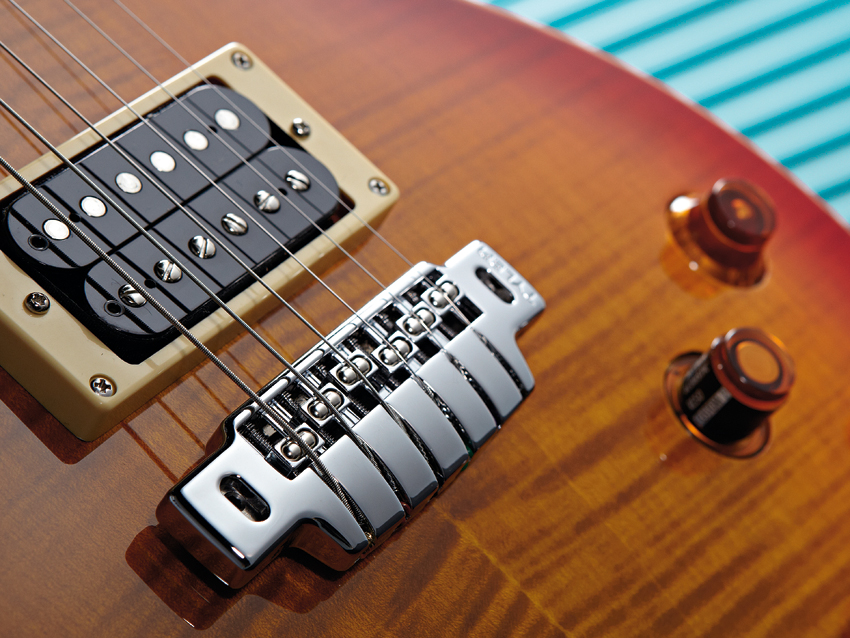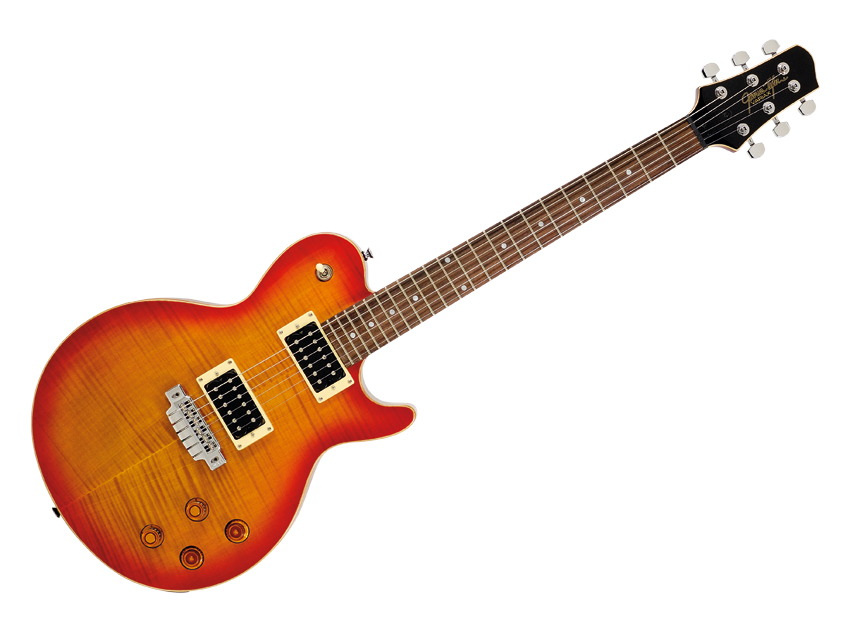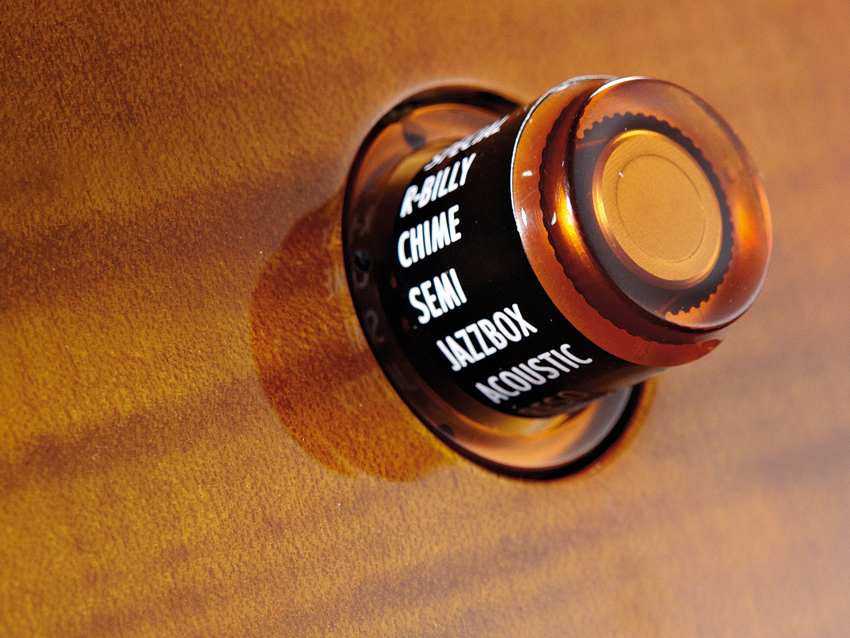MusicRadar Verdict
This is a huge palette of sounds on a classic canvas. The JTV59 is a brilliantly versatile instrument. Just make sure you get one that's light enough for you…
Pros
- +
The spot-on modelling sounds; it's genuinely easy to use; excellent playability.
Cons
- -
You might have to knock back a can of spinach to lift it.
MusicRadar's got your back

Line 6 James Tyler Variax JTV59

Line 6 James Tyler Variax JTV59

Line 6 James Tyler Variax JTV59
This might seem like a dispatch from the Ministry of the Bleedin' Obvious but the new JTV59 is based on the Gibson Les Paul.
Even if the '59' in the model designation didn't tip you off, the JTV's single-cutaway mahogany and maple constructed body is a dead giveaway. Adding to the established old-school vibe is James Tyler's '59 profile set-neck, which is pleasantly plump while not feeling much more than a handful.
"The twin vintage-voiced, alnico-magnet powered humbuckers are wired to a master volume, master tone and a three-way toggle switch for the classic Les Paul pickup combinations."
The JTV's neck heel is sculpted to offer good access to each of the 22 well-seated and dressed jumbo frets; the Les Paul-a-like 305mm (12-inch) rosewood fingerboard radius adds to a playing experience that's pretty much as good as the real thing.
The twin vintage-voiced, alnico-magnet powered humbuckers are wired to a master volume, master tone and a three-way toggle switch for the classic Les Paul pickup combinations.
While this is all textbook stuff we should point out a curious anomaly we unearthed with the JTV59. We actually had two examples of this guitar at our disposal and found that there was a good pound and a half of difference in weight between them.
Our cherry sunburst model was the heaviest at 10lbs. That would have The Incredible Hulk reaching for the Ralgex after a night with this guitar hanging from a strap.
What we're saying is, strap on a few examples before you unload your bank account on a JTV59 and get one you're comfortable with.
Obviously the JTV59 is more than just a good mid-range Les Paul derivative. It's a Variax, so you get access to an onboard arsenal featuring classic electrics (a '60 Tele Custom, '59 Stratocaster, '58 Gibson Les Paul Standard, '59 Gretsch 6120 and '66 Rickenbacker 360-12), jazz boxes (a '57 Gibson ES-175 and '53 Gibson Super 400), iconic acoustics (a '59 Martin D-28, '95 Gibson J-200 and a '35 Dobro Alumilite) and a couple of quirky items (the Coral/Dano Elektrische Sitar and a Gibson Mastertone banjo).
You also get alternative tunings: standard, drop D, a half step down, drop Db, one full step down, DADGAD, open D, blues G, reso G, open A and baritone.
Sounds
Getting to grips with a Variax is pretty intuitive. That's one of the reasons the technology has survived the past 10 years: it's easier to use than the competition.
And it sounds great too. We raved about the improvement in the sounds of the next generation Variax when we tried the US JTV69 back in the day, and obviously, with the Korean models carrying the same brilliant seed we're just as impressed. In a way we're even more blown away given the substantial difference in price with the new JTVs and the American jobs.
You'll probably have to take some of the Variax modelling sounds at face value. While the Strat, Les Paul and banjo models are easy to place, some of us won't know what the neck pickup on a 1968 Fender Telecaster Thinline or 1976 Gibson Firebird V is supposed to sound like. The same applies to the subtle difference between a 1959 Martin D-28 and a 1967 Martin 0-18.
In those cases you have to enjoy the sounds for what they are; appreciate how they sound in the mix. If the '59 Strat doesn't work, try the fatter-sounding Danelectro 3021 modelled with both pickups engaged.
We do find the 12-string and detuned settings still sound a bit synthetic here but they are dramatically improved in a mix. The acoustic sounds benefit from the sympathetic frequency range of an acoustic guitar amp or PA system.
The banjo model is as brilliant as the Coral sitar is bonkers. If the closest you've ever got to a sitar is having fret buzz on your guitar then you're in for a treat.
Yep, the JTV59 has been worth the wait, with bells on. While the alternative JTV69 and 89 designs mean there really is a Variax for everyone, that doesn't mean the target market has changed.
The Variax has always been an indispensable tool for the right player. That means studio and club guitarists looking for instant access to myriad tones and alternate tunings.
A face-lift and magnetic pickups can't really change an instrument's demographic. We reckon that many existing Variax fans will upgrade to the Korean models, but the JTVs prove the Variax concept has not only stood the test of time, it's looking good for another decade at the top.
“A synthesizer that is both easy to use and fun to play whilst maintaining a decent degree of programming depth and flexibility”: PWM Mantis review
“I feel like that song had everything we needed to come back with”: Bring Me The Horizon’s Lee Malia on Shadow Moses, its riff and the secrets behind its tone, and why it was the right anthem at the right time
“I said, ‘Are we sure we can write a song about death?’”: The story of Mike + The Mechanics' classic No.1 The Living Years









